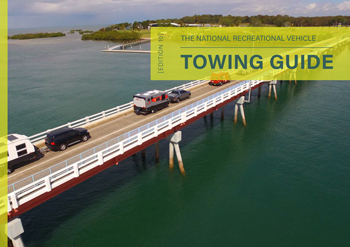RV Terminology & Definitions
A glossary of commonly used terminology within the RV industry.
A
A Frame
This is the front section of the trailer or caravan chassis to which the coupling body is attached with bolts, nuts and locking washers.
ATM (Aggregate Trailer Mass)
The total weight of a caravan or trailer on all wheels, plus the tow ball mass and whatever you add as personal payload. (E.g. water, gas, luggage). The ATM is specified by the manufacturer and must not be exceeded.
Awning
A tent like structure that fits to the side of a caravan so to extend the living space of the caravan.
B
Berth
This refers to the amount of people that a caravan can sleep.
Bulkhead
A structural wall within the hull of the van.
C
Chassis
The frame of a vehicle or motor home including the engine, transmission, drive train, axles, and wheels. When referring to a van or truck, the chassis also includes the cab.
Coupler
The part of the trailer that attaches to the ball of the hitch.
D
Dry Bath
A bathroom in an RV where the toilet and shower are in separate areas of the bathroom typically separated by a shower curtain.
Dump Point
A place where waste water or grey water tanks are emptied. Usually a small concrete pad with a 3 to 4-inch brass fitting embedded into the concrete. The fitting accepts a sewer hose from the RV. Sewage dumped into the station goes into a sewer or a septic system. Dump stations are usually situated so that an RV can be driven next to the receptacle. Dump stations often have running water for rinsing the RV’s sanitary pipes and for cleaning up the dump station pad. This water should not be used to fill an RV’s potable water tank. RV etiquette demands that the user of an RV dump station cleans up any spills.
F
Flat Towing
Towing a vehicle four wheels down behind a motorhome, with the intent of unhooking the towed vehicle and using for sightseeing or local driving.
G
GCM (Gross Combination Mass)
GCM is the rating provided by the manufacturer of the tow vehicle. The maximum laden mass of a motor vehicle plus the maximum laden weight of an attached trailer is not permitted to exceed the GCM rating.
GTM (Gross Trailer Mass)
The total weight of a caravan or trailer on all wheels, plus your personal payload, including water, gas and any accessories you fit. This does not include the mass supported by the tow ball. This figure must not exceed the rating for the axle group (wheels, tyres, suspension and axle) specified by the chassis manufacturer.
GVM (Gross Vehicle Mass)
The GVM (gross vehicle mass) is the maximum allowable total mass of a fully loaded motor vehicle, consisting of the tare mass (mass of the vehicle) plus the load (including passengers).
Guy Lines
Cords are attached to the outside of an awning or trailer tent to stabilise and tension the fabric.
H
Holding Tanks
Tanks that collect waste or grey water and also freshwater.
J
Jockey Wheel
Small wheel at the front of a caravan used to support the forward end of the caravan while it is not hitched up. Allows the caravan to be manoeuvred by hand, or ‘jockeyed’ into position.
L
Leaf Spring Stabiliser
An add-on device which can help prevent instability by controlling the ease with which the caravan hitch can pivot about the tow ball.
Levelling
The process of ensuring that a caravan or motor caravan is level when set up on a pitch. Important for comfort, and also to ensure the correct functioning of the drinking water and waste water systems.
P
Payload
Payload is specified by the manufacturer. It must not be exceeded under any circumstances. Safety, insurance and warranty may be affected if the specified payload is exceeded.
Personal Payload or Load-carrying Capacity
The total permitted load that may be legally carried in the van or trailer, this includes all items added to your trailer or caravan such as clothes, food, crockery, tools, water, gas and any accessory you install. Subtract the tare from the ATM and you have the load-carrying capacity.
S
Slide out
An addition that extends beyond the normal outside walls to expand the living, sleeping, dining or galley areas.
Single Axle
A caravan with a single pair of wheels on one axle.
Six Axle
A caravan with three pairs of wheels, on three axles.
Stabiliser
A safety device that helps prevent instability by controlling the ease with which the caravan hitch can pivot about the tow ball.
Sway or Snake
When the towing vehicle whilst moving begins to swing back and forth.
T
Tare Weight or Tare Mass
The total weight of a caravan or trailer on all wheels, plus ball weight. The tare does not include your personal payload nor water and gas. This is what it weighs when it leaves the production line. Like the ATM, but unlike the GTM, it combines the mass that rests on the tyres and the mass that rests on the tow ball.
Tow Ball Mass
The weight imposed on the tow vehicle’s tow ball by the trailer or caravan’s coupling. The ball load should always be eight to 15 per cent of the ATM. A van should always be loaded with any heavy items near the axle, and not at the extreme ends where they will alter the ball load.
Twin Axle
A caravan with two pairs of wheels, on two axles which are located close together. These are usually the larger, heavier caravans, where the second axle helps carry the greater weight more easily, and also makes a longer caravan more stable to tow.
V
VIN
A vehicle identification number is a unique code including a serial number, used by the automotive industry to identify individual motor vehicles, towed vehicles etc.
W
Waste Water or Grey Water
Water that has been used in the kitchen or bathroom area. This should be collected in an internal tank or external container for later disposal at a designated emptying point on the site.
Wet Bath
A bathroom in an RV where the shower and toilet stall are combined into the same room. That is, the toilet is in the shower.
Wheelbase
Distance between the centre of the front and rear wheels of a vehicle.
Grab a copy of the National Towing Guide here.




